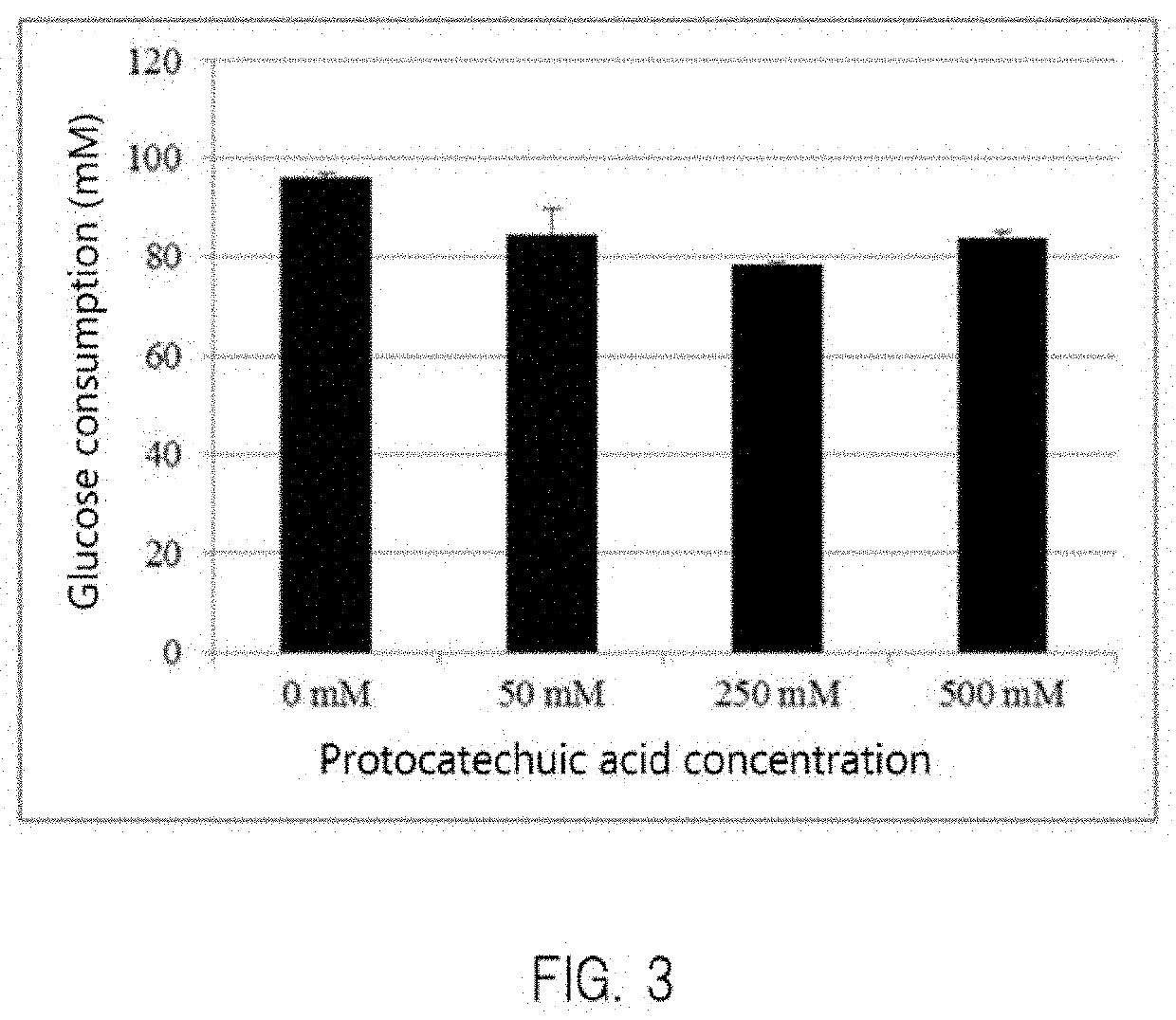Transformant, and method for producing protocatechuic acid or salt thereof using same
a protocatechuic acid and transformation method technology, applied in the direction of carbon-carbon lyases, lyases, bacteria-based processes, etc., can solve the problems of low extraction efficiency, difficult mass production of protocatechuic acid, and practically sufficient efficiency in the production of these substances, so as to enhance the activity of chorismate pyruvate lyase and lyase activity, and enhance the activity of chorismate pyruvate and lyas-y a protocatechuic acid production method, protocatechuic acid production method, protocatechuic acid production method, protocatechuic acid and protocatechuic acid and protocatechuic acid and protocatechuic acid and protocatalytic acid and protocatalytical applied in the field of protocatalytical technology, which which is applied in the field of protocatalytical technology, can solve the problem of low rate of protocatalytical problem of lysic acid problem
- Summary
- Abstract
- Description
- Claims
- Application Information
AI Technical Summary
Benefits of technology
Problems solved by technology
Method used
Image
Examples
reference example 1
Verification that Coryneform Bacterium Exhibits High Resistance Against Protocatechuic Acid, as Compared with Other Microorganisms
[0305]In a case where a product that has cytotoxicity, such as protocatechuic acid, is produced by the fermentation process using microorganisms, it is important that a host microorganism has resistance against the product, that is, hardly suffers from growth inhibition by the product. Then, for studying the degree of resistance against protocatechuic acid of Corynebacterium glutamicum, which is preferable as a host microorganism in the present invention, in comparison with other microorganisms, studies were made on the inhibition by protocatechuic acid of the growth of Corynebacterium glutamicum, Escherichia coli, Bacillus subtilis, Pseudomonas putida, Rhodococcus erythropolis, and Saccharomyces cerevisiae in aerobic culture.
[0306]Corynebacterium glutamicum strain R was applied to an A-agar plate [obtained by dissolving the following in distilled water 1...
reference example 2
Verification that Coryneform Bacterium has High Saccharide Consumption Ability Under Presence of High Concentration of Protocatechuic Acid
[0317]As indicated in Reference Example 1, Corynebacterium glutamicum was able to grow even under the presence of a high concentration of protocatechuic acid. Then, a glucose consumption ability of Corynebacterium glutamicum under the presence of a high concentration of protocatechuic acid was further studied in the following manner.
[0318]Corynebacterium glutamicum strain R was applied to the above-described A-agar plate containing glucose 4%, and was cultured at 33° C. for 16 hours. One platinum loop of Corynebacterium glutamicum strain R grown on the above-described plate was inoculated in a test tube having therein 10 ml of the above-described A-liquid medium containing glucose 4%, and was subjected to aerobic shaking culture at 33° C. for 16 hours. Corynebacterium glutamicum strain R grown under the above-described conditions was inoculated in...
example 2
Test of Protocatechuic Acid Production by Aerobic Reaction of Non-Growing (Resting) Bacterial Cells of Corynebacterium glutamicum Transformant Under Control of Jar Fermenter
[0321]Regarding protocatechuic acid producing strains constructed on the basis of strains utilizing mixed saccharides, derived from Corynebacterium glutamicum strain R, which are PCA1, PCA2, PCA3, PCA4, PCA5 (Example 1 (Table 6)), their protocatechuic acid producing abilities in the aerobic reaction of non-growing (resting) bacterial cells under the control of a jar fermenter (manufactured by Able Corp., Type: BMJ1L) were confirmed in the following manner.
[0322]Strain PCA1 was inoculated in 10 ml of the above-described A-liquid medium (in a test tube) to which phenylalanine, tyrosine, and tryptophan, 20 μg / ml each, p-amino benzoate 10 μg / ml, shikimate 3.2 mM, and glucose 4% (in the final concentrations) were added, and further, strains PCA2, PCA3, PCA4, and PCA5 were inoculated in 10 ml of the above-described A-l...
PUM
| Property | Measurement | Unit |
|---|---|---|
| pH | aaaaa | aaaaa |
| pH | aaaaa | aaaaa |
| pH | aaaaa | aaaaa |
Abstract
Description
Claims
Application Information
 Login to View More
Login to View More - R&D
- Intellectual Property
- Life Sciences
- Materials
- Tech Scout
- Unparalleled Data Quality
- Higher Quality Content
- 60% Fewer Hallucinations
Browse by: Latest US Patents, China's latest patents, Technical Efficacy Thesaurus, Application Domain, Technology Topic, Popular Technical Reports.
© 2025 PatSnap. All rights reserved.Legal|Privacy policy|Modern Slavery Act Transparency Statement|Sitemap|About US| Contact US: help@patsnap.com



